Iarmhumhain (older spellings: Iarmuman, Iarmumu or Iarluachair) was a Kingdom in the early Christian period of Ireland in west Munster. Its ruling dynasty was related to the main ruling dynasty of Munster known as the Eóganachta. Its ruling branch was called the Eóganacht Locha Léin or Ui Chairpri Lúachra. Their center was around Killarney, County Kerry at Loch Léin. The name Iarluachair means west of the Sliabh Luachra mountains.

Munster is one of the provinces of Ireland, in the south west of Ireland. In early Ireland, the Kingdom of Munster was one of the kingdoms of Gaelic Ireland ruled by a "king of over-kings". Following the Norman invasion of Ireland, the ancient kingdoms were shired into counties for administrative and judicial purposes. In later centuries, local government legislation has seen further sub-division of the historic counties.

The Eóganachta or Eoghanachta were an Irish dynasty centred on Cashel which dominated southern Ireland from the 6/7th to the 10th centuries, and following that, in a restricted form, the Kingdom of Desmond, and its offshoot Carbery, to the late 16th century. By tradition the dynasty was founded by Conall Corc but named after his ancestor Éogan, the firstborn son of the semi-mythological 3rd-century king Ailill Aulom. This dynastic clan-name, for it was never in any sense a 'surname,' should more accurately be restricted to those branches of the royal house which descended from Conall Corc, who established Cashel as his royal seat in the late 5th century.
Eóganacht Locha Léin or Ui Caipre Luachra were a branch of the ruling Eoganachta of Munster. Their territory was in Iarmuman or West Munster. Luachair (Lúachra) is the old name of a large district on the borders of Co Cork, Kerry and Limerick. Cairbre of Sliobh Luachra was on the Cork-Kerry border; Éoganacht Locha Lein is around the Lakes of Killarney.
The dynasty was established in the 5th century with the kingdom becoming semi-independent of the Munster kings at Cashel in the 6th century. They ruled over smaller kingdoms in west Munster such as the Ciarraige Luachra, Corcu Duibne and Corcu Loígde and at the height of their power may have ruled over areas of west Thomond including the Corcu Baiscinn and Corco Mruad and perhaps even had some sovereignty over the Uí Fidgenti of County Limerick and the Eóganacht Raithlind of County Cork.

Cashel is a town in County Tipperary in Ireland. Its population was 4,422 in the 2016 census. The town gives its name to the ecclesiastical province of Cashel. Additionally, the cathedra of the Roman Catholic Archdiocese of Cashel and Emly was originally in the town prior to the English Reformation. It is part of the parish of Cashel and Rosegreen in the same archdiocese. One of the six cathedrals of the Anglican Bishop of Cashel and Ossory, who currently resides in Kilkenny, is located in the town. It is in the civil parish of St. Patricksrock which is in the historical barony of Middle Third.

The Corcu Duibne, which means "seed or tribe of Duibhne", was a notable kingdom in prehistoric and medieval County Kerry, Ireland which included the Dingle Peninsula, the Iveragh Peninsula and connecting lands. The tribe belonged to the Érainn and claimed descent from the legendary Conaire Mór, possibly making them distant cousins of such far off kingdoms as Dál Riata in Ulster and Scotland, as well as the closer Múscraige and Corcu Baiscind. All the tribes belonged to the Síl Conairi of legend and ultimately traced their descent from the Clanna Dedad.
The Corcu Loígde, meaning Gens of the Calf Goddess, also called the Síl Lugdach meic Itha, were a kingdom centred in West County Cork who descended from the proto-historical rulers of Munster, the Dáirine, of whom they were the central royal sept. They took their name from Lugaid Loígde "Lugaid of the Calf Goddess", a King of Tara and High King of Ireland, son of the great Dáire Doimthech. A descendant of Lugaid Loígde, and their most famous ancestor, is the legendary Lugaid Mac Con, who is listed in the Old Irish Baile Chuinn Chétchathaig. Closest kin to the Corcu Loígde were the Dál Fiatach princes of the Ulaid.
Their power was broken in the late 8th and early 9th centuries. The transference of the overlordship of the Ciarraige Luachra to direct Cashel control in the reign of Feidlimid mac Cremthanin (died 846) signified this. The last time the title King of Iarmuman was used in the Annals of Innisfallen was 791 and in the Annals of Ulster 833. The dynasty then begins to use the title king of Loch Léin.
